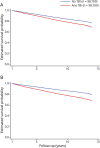Traumatic Brain Injury and Incidence Risk of Sleep Disorders in Nearly 200,000 US Veterans
- PMID: 33658328
- PMCID: PMC8055309
- DOI: 10.1212/WNL.0000000000011656
Traumatic Brain Injury and Incidence Risk of Sleep Disorders in Nearly 200,000 US Veterans
Abstract
Objective: To test the hypothesis that veterans with traumatic brain injury (TBI) have an increased subsequent risk of sleep disorders, we studied the longitudinal association between TBI and incident sleep disorders in nearly 200,000 veterans.
Methods: We performed a cohort study of all patients diagnosed with a TBI in the Veterans Health Administration system from October 1, 2001, to September 30, 2015, who were age-matched 1:1 to veterans without TBI. Veterans with prevalent sleep disorders at baseline were excluded. Development of sleep disorders was defined as any inpatient or outpatient diagnosis of sleep apnea, hypersomnia, insomnia, or sleep-related movement disorders based on ICD-9 codes after the first TBI diagnosis or the random selection date for those without TBI. We restricted the analysis to those with at least 1 year of follow-up. We used Cox proportional hazards models to examine the association between TBI and subsequent risk of sleep disorders.
Results: The study included 98,709 veterans with TBI and 98,709 age-matched veterans without TBI (age 49 ± 20 years). After an average follow-up of 5 (1-14) years, 23,127 (19.6%) veterans developed sleep disorders. After adjustment for demographics, education, income, and medical and psychiatric conditions, those who had TBI compared to those without TBI were 41% more likely to develop any sleep disorders (hazard ratio 1.41 [95% confidence interval 1.37-1.44]), including sleep apnea (1.28 [1.24-1.32]), insomnia (1.50 [1.45-1.55]), hypersomnia (1.50 [1.39-1.61]), and sleep-related movement disorders (1.33 [1.16-1.52]). The association was stronger for mild TBIs, did not differ appreciably by presence of posttraumatic stress disorder, and remained after a 2-year time lag.
Conclusion: In 197,418 veterans without sleep disorders, those with diagnosed TBI had an increased risk of incident sleep disorders over 14 years. Improved prevention and long-term management strategies for sleep are needed for veterans with TBI.
© 2021 American Academy of Neurology.
Figures


References
-
- Ouellet MC, Beaulieu-Bonneau S, Morin CM. Sleep-wake disturbances after traumatic brain injury. Lancet Neurol 2015;14:746–757. - PubMed
-
- Collen J, Orr N, Lettieri CJ, Carter K, Holley AB. Sleep disturbances among soldiers with combat-related traumatic brain injury. Chest 2012;142:622–630. - PubMed
-
- Imbach LL, Buchele F, Valko PO, et al. . Sleep-wake disorders persist 18 months after traumatic brain injury but remain underrecognized. Neurology 2016;86:1945–1949. - PubMed
Publication types
MeSH terms
Grants and funding
LinkOut - more resources
Full Text Sources
Other Literature Sources
Medical
